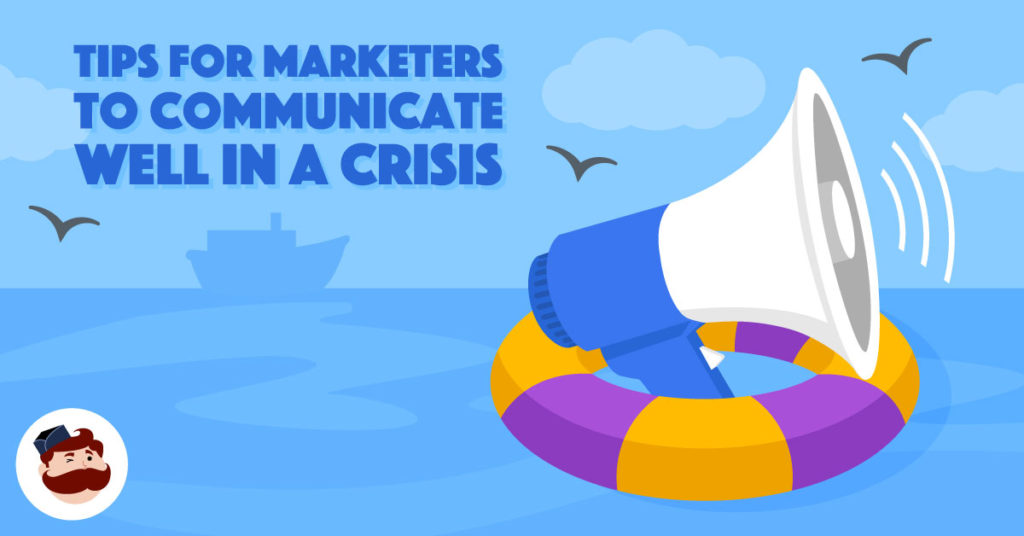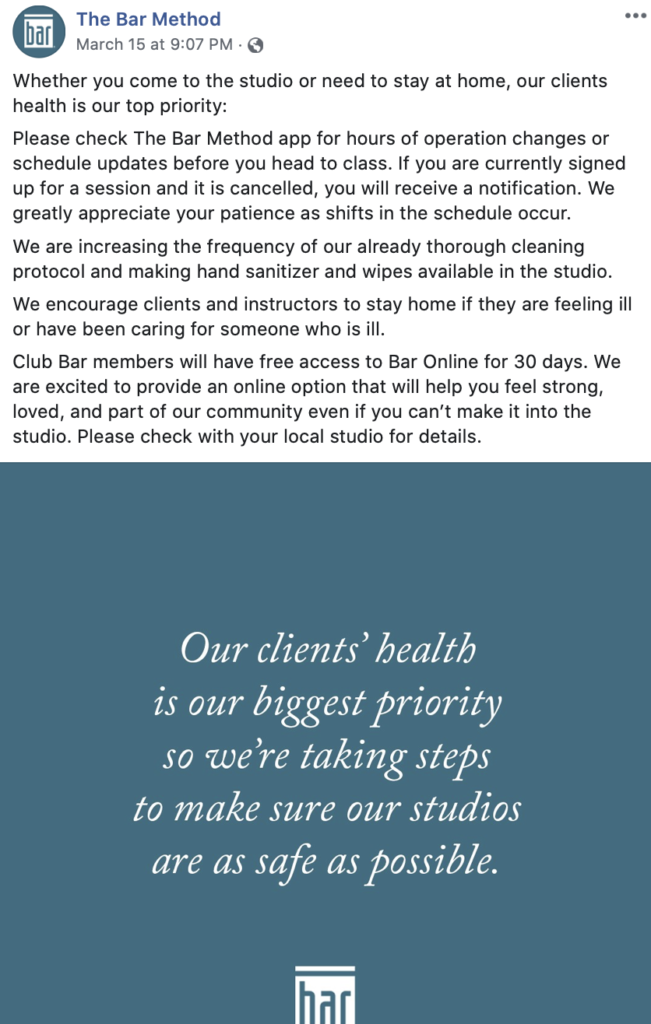Strong crisis communication across social media marketing is essential right now.
No matter what continent you’re on or the type of work you do, your world has almost certainly been turned upside down.
Everyone’s life has been dramatically changed over the matter of a few weeks, even if it felt like it was overnight.
If you’re wondering how exactly to communicate in a way that builds relationships with your audience instead of driving them away or contributing to the fear, keep reading!
In this post, we’re going to look at specific strategies you can use to communicate and market effectively during a crisis without coming across as exploitative or untrustworthy.
With the COVID-19 virus proving deadly and easily transmissible, businesses are being forced to adapt lightning-fast to a new normal, which may even mean closing their doors temporarily and wait for it to be all out.
If you’re worried, that’s okay. We’re worried, too. The good news is that while we’re all fighting a battle, there’s a lot we can control.
One of those things is how well we social distance if we can stay home. Another is how we’re reaching out to our audience during this time.
There’s a lot that businesses can learn from what’s happening in the world today and how to communicate effectively even when there’s so much uncertainty.
We’re here to help.
Here are six tips for marketers to improve crisis communication with their customers.
1. Address the Crisis Head On
One thing we’ve seen people asking recently is whether or not they actually need to change their marketing strategy.
They want to know if they need to stop the emails they’d already drafted, pause the ad campaigns rolling out, and change up their message on social.
The answer is a bit complicated: Yes, and no.
But no matter what, you need to carefully and intentionally address the crisis head-on.
Right now, I’d be concerned if a brand I followed closely didn’t even mention the virus. I’d wonder if they weren’t taking it seriously, if they didn’t care, or if they were trying to protect their workers and customers well. Something about it also feels uncomfortable, like the brand just doesn’t care.
Even early on, when brands weren’t sure if they’d have to shut down, customers were looking to social for answers.
You should include content focusing on crisis communication within your strategy now.
This doesn’t mean that every post needs to mention the coronavirus, but it should be a topic of discussion.
You’ll want to explain how the virus will impact your team and your customers in a public post, being detailed if necessary. Then discuss what you plan to do to keep your staff safe, keep your doors open, and give back to the community if relevant.
If you aren’t doing this, you could lose trust rapidly, especially since every other business out there is using some combination of email and social marketing to spread these messages of their own.
Keep in mind that your customer’s entire world has been knocked off-kilter, too. Their therapist is switching to telehealth visits, they might have limited hours of when they can go to the grocery store, their work has shifted to entirely remote, and they can’t even go burn off stress at the gym.
2. Ask Your Customers What They Need
This tip is simple, but it works, and it allows you to shape your crisis communication and marketing strategies towards your specific audience by simply asking what they need and what they want to see.
This isn’t a terrible strategy, to begin with, but it can be even more powerful now.
We’ve all lost a sense of control, which often happens in most widespread crises, and it’s hard to know exactly how to move forward sometimes.
Ask your customers directly how your business can support them, and what types of content they’d like to see.
If your audience is overwhelmingly saying, “I just want more happy content,” you can deliver that.
If they say “we need entertainment,” you can create a social pop-quiz where you ask questions in Stories or on Facebook and see what answers people send.
Others might say “help us navigate this,” in which case you know you need to pivot to create timely content that’s useful to your audience right now.
Flower and bouquet delivery company Bouqs used this strategy.
They addressed the crisis, talking about how they hoped to be a bright spot in the social feeds, but also acknowledging that this may not be what their audience wanted to see.
They asked, framing it as “we want to be there for you and give you what you need,” transparently letting their customers know that their needs would shape their marketing strategy in the coming weeks.
Not only is this seen as transparent, authentic, and customer-first, it also keeps you from needing to play the guessing game.
3. Offer Relevant, Timely Value
If you have information or knowledge that’s useful to social media users in the time of a crisis, share it.
When a crisis hits, most people aren’t always entirely sure how to react or prepare if it’s new to them.
In the week when people in my hometown started realizing the virus was a threat, they grabbed bottled water, lanterns, toilet paper, beer, and potato chips off the shelves; these were all things that people were used to reaching for during a hurricane.
Nevermind the fact that our fridges and freezers weren’t likely to get knocked out of commission from a power outage so we could buy perishable food. Or that in those same fridges, for some reason, Tylenol, Motrin, and cough syrup were living on the shelves like it was all irrelevant.
When you can be of value during a crisis, do so.
If you’re genuinely helping, it won’t come across as exploitive as long as you’re keeping mentions of your product to an absolute minimum.
A great example of this is from Williams Sonoma.
They shared their list of all the food and ingredients that you should buy immediately in case stores shut down, broken down into what goes into your pantry, your fridge, and your freezer. They did tag some of their products quietly in the background, but the list itself was useful, and it generated a ton of discussion.
As you’re creating content centered around the crisis, you’ll likely see comments trickling in that may address your audience’s new needs and fears.
Oversee these comments using social management tools like Hootsuite so that you never miss a message or a chance to reach out to a worried customer.
4. Offer Transparent, Relevant Updates, Focused Around Crisis Communication
When something changes suddenly and drastically, social is now one of the first places your audience will turn to find more information about what this means for their relationship with your business.
Because of this, continually offering updates during a crisis on your Facebook Page and other social profiles is the right call.
You can pin posts at the top of the Page stating these changes, which may include the length of time you’ll have your brick-and-mortar closed or what solutions you’re offering in the meantime (like online classes).
Transparency and authenticity are good here, just as they are with all crisis communication.
My kickboxing studio Woo Kickboxing had to share one of these announcements recently, informing students they’d be closing up shop and reminding them to tune in for an online daily workout.
They were also fully transparent in thanking everyone who was keeping their membership going as it was the only thing keeping them in business and able to return once this as all over.
5. Thank Your Customers
Take the time to thank your customers for their ongoing support. This is so important.
People are losing their jobs left and right, even if it’s “only temporarily.” Their continued support to your business even during a crisis speaks volumes, and it should absolutely be acknowledged.
A public post that will permanently live in your feed should thank your customers publicly for their ongoing support, and announce your excitement for things to return to normal (even if it’s a new normal).
While thank you’s in Stories are great, you want this to be as visible as possible.
You can acknowledge how hard the crisis has been for your business, in particular, offering a transparent look that can build trust and loyalty.
6. Address Pain Points Without Fear-Mongering
Businesses still need to be marketing right now, even while they’re focused on crisis communication.
It can feel a little gross to think about trying to drive sales, but we’re in crunch time; if we aren’t driving sales, our businesses can’t survive long term, and that’s important, too.
An excellent way to market successfully right now is to address existing pain points without fear-mongering.
This won’t come across as exploitive, but it still gives you a clear reason why customers need to buy now even if the economic situation is a little more fraught.
Let’s look at an example.
This ad from Island Creek Oysters subtly addresses common pain points right now– low mood and worries about health– by saying their products are “power-packed vitamins and minerals to keep your immunity and spirits high.”
They’re walking a fine line, and they’re doing it well.
They aren’t promising that their oysters are all you need to keep you healthy, or that this will save you from the virus. They never mention the virus directly.
Instead, they talk about the health benefits and use the image to speak about the different nutrient values.
The timely content of the pain point and the title image “Stay Home. Eat More Oysters” make it immediately relevant, but without crossing a line of talking about people dying, how immune systems are weak, and how scary the virus is.
It’s quietly compelling, and it’s “tasteful,” which is an excellent place to be.
Final Thoughts
Businesses have a lot to worry about during a crisis.
They need to tackle issues with delays in supply, concerns over investors pulling out during economic hardship, and worries about how they’ll make payroll, rent, and pay key vendors.
The last thing you want to happen is to be unsure of how to go about marketing to your audience during a time when crisis communication is essential for your relationships with your customers.
Following these six strategies will help keep your brand relevant in a positive, valuable way that your audience will remember long after the crisis has passed.
What do you think? What crisis communication strategies are you using right now? How is your business holding up? Is there anything you need help with that we can cover on our blog? Let us know how we can support you in the comments below!




As a video content producer, I’d also suggest scheduling a live-streamed event to give a face to the crisis management.
Agree?
Thanks!